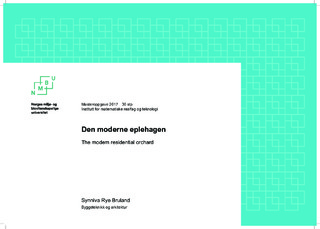| dc.contributor.advisor | Houck, Leif Daniel | |
| dc.contributor.author | Bruland, Synniva Rye | |
| dc.coverage.spatial | Norway, Sarpsborg | nb_NO |
| dc.date.accessioned | 2017-11-09T09:16:32Z | |
| dc.date.available | 2017-11-09T09:16:32Z | |
| dc.date.issued | 2017 | |
| dc.identifier.uri | http://hdl.handle.net/11250/2465115 | |
| dc.description.abstract | Med dagens befolkningsvekst øker behovet for flere boliger. Det stilles høye krav til fortettingspolitikken for å oppnå en bærekraftig byutvikling. Det oppfordres til å fortette nær kollektivknutepunkt og innenfor eksisterende tetthetsgrenser. Dette bidrar til å hindre en byspredning og tar hensyn til miljø- og klimaproblematikken. Sarpsborg er en by som ønsker å imøtekomme forventet vekst gjennom fortetting og transformasjon. Kommunens arealplan for 2015-2026 setter et mål for økt bolig- og næringsvekst i sentrum. Frem mot år 2050 skal 50% av boligbyggingen skje innenfor en radius på 2 km fra torget.
I denne masteroppgaven presenteres en fortetting av et område innenfor Sarpsborgs villabebyggelse. Eneboligstrukturen er den dominerende boligtypen i Sarpsborg og flere lavt arealutnyttet kvartal ligger tett på bykjernen. Målet er at fortettingsområdet skal utvikles med en god forankring til omkringliggende bebyggelse. Prosjektområdet grenser til både blokk og villabebyggelse. Oppgaven vil derfor gi et forslag til hvordan fortette med fokus på en god overgang fra lav til høy bebyggelse. Det er også lagt fokus på å utvikle et fortettingsområde med fleksibilitet.
For å kombinere kvalitetene fra villabebyggelsen med behovet for fortetting, er det utarbeidet en stedsanalyse for å finne overordnede føringer i området og i eksisterende bebyggelse. Av kvaliteter er det mye fin arkitektur, gode tilganger på grønnstruktur og kollektivforbindelser, og synlige byhistoriske føringer. Noen av de største utfordringene er mye trafikk og støy tett på uskjermet bebyggelse og eneboliger med lav arealutnyttelse i randsonen av bykjernen.
Litteraturstudiet belyser hvordan fortette en hagebybebyggelse på en bærekraftig måte for å oppnå gode bokvaliteter, noe som er målet i masteroppgaven. Dette har vært til en veiledning i utviklingen av det endelige løsningsforslaget med hovedfokus på stedsidentitet, tilpasset bygningsstruktur, nær kontakt mellom ute og inne, gode fellesareal, flyt og variasjon i boligene, trygghet og bærekraft. | nb_NO |
| dc.description.abstract | With today’s population growth there is a continuous increasing demand for more housing. To achieve a sustainable urban development, high demands for densification policies are set. Encouragements are made for densification close to public transportation hubs and existing urban areas. This helps prevent urban sprawl and takes into account environmental and climate issues. Sarpsborg is a city that aim to meet expected growth through densification and transformation. The municipality’s plan for land use for 2015-2026 sets a goal for increased housing and business growth in the center of the city. By the year 2050, 50% of the housing construction will take place within a radius of 2 km from the city center.
This master thesis presents a densification of an area within Sarpsborg’s detached residential buildings. Detached housing structure is by far the dominant housing type in Sarpsborg. Several quarters with low area utilisation is located close to the city center. The goal is to develop the densification area with a good foundation for surrounding buildings. The project area adjoins both block and detached residential buildings, and the task will therefore provide a proposal for how to focus on a good transition from low to high buildings. There is also a focus on developing a densification area with flexibility.
In order to combine the quality of the residential development with the need for densification, a site analysis has been prepared to find guidelines in the area and in existing buildings. Attractive architecture, easy access to green structure, good coverage of public transportation, and visible history are some of the qualities. Some of the main challenges are traffic noise from the main road close to unshielded buildings, and detached houses with low area utilisation close to the city center.
The literature study illustrates how to densify garden-city buildings in a sustainable way to achieve good residential quality, which is the goal of the master’s thesis. This has been a guide in the development of this final solution with the focus on place identity, adapted building structure, close contact between inside and outside, good common area, flow and variety in housing, safety, and sustainability. | nb_NO |
| dc.language.iso | nob | nb_NO |
| dc.publisher | Norwegian University of Life Sciences, Ås | nb_NO |
| dc.rights | Attribution-NonCommercial-NoDerivatives 4.0 Internasjonal | * |
| dc.rights.uri | http://creativecommons.org/licenses/by-nc-nd/4.0/deed.no | * |
| dc.subject | Fortetting | nb_NO |
| dc.subject | Bærekraft | nb_NO |
| dc.subject | Stedsidentitet | nb_NO |
| dc.subject | Boliger | nb_NO |
| dc.title | Den moderne eplehagen | nb_NO |
| dc.title.alternative | The modern residential orchard | nb_NO |
| dc.type | Master thesis | nb_NO |
| dc.subject.nsi | VDP::Teknologi: 500::Bygningsfag: 530::Arkitektur og bygningsteknologi: 531 | nb_NO |
| dc.source.pagenumber | 118 | nb_NO |
| dc.description.localcode | M-BA | nb_NO |

